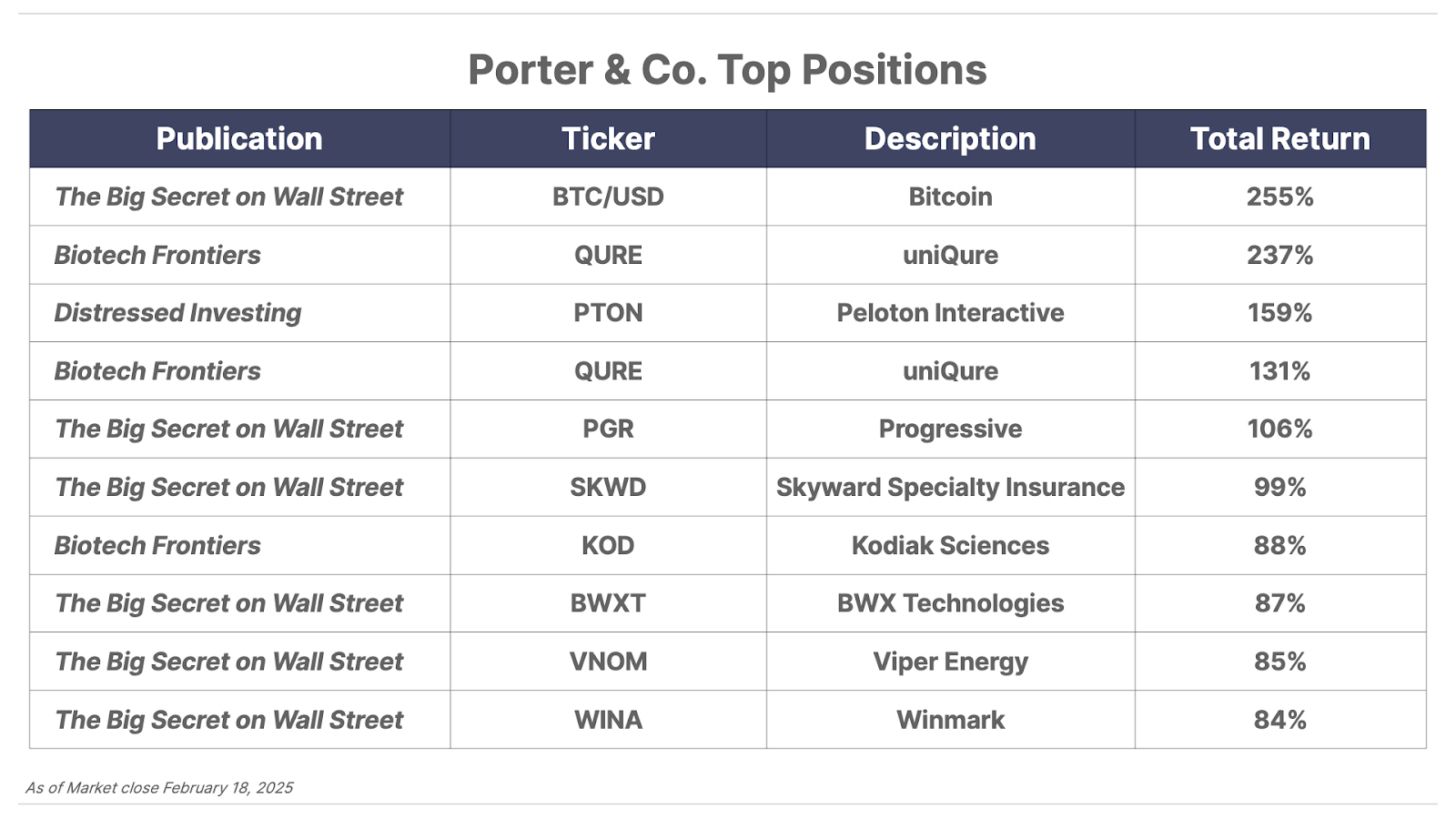Issue #20, Volume #2


And The Investment Lessons Learned Along The Way
This is Porter & Co.’s free e-letter, the Daily Journal. Paid-up members can access their subscriber materials, including our latest recommendations and our “3 Best Buys” for our different portfolios, by going here. Recent issues of the Daily Journal are here.
| Learning investment lessons from a game of liar’s poker… Senior traders took advantage of the young quants… Dissecting the gambling game to level the playing field… Consumer credit is blowing up… Fund managers are all in with their cash… |
Showing the guys who think they know it all that, in fact, they actually don’t… is a great feeling.
And that’s especially the case when the know-it-all guys are BSDs (that is… they think their manhoods are bigger than anyone else’s) on a 1980s bond trading floor.
As context… in the October 23, 2024, Daily Journal (“Bonds And Liar’s Poker At Salomon Brothers”), Distressed Investing senior analyst Martin Fridson recounted his experiences with the colorful Salomon Brothers bond traders portrayed in Michael Lewis’s 1989 best seller, Liar’s Poker.
Marty shared stories about then-CEO John Gutfreund, who personified the scrappy, my belt-is-longer-than-yours culture of high-stakes bond trading of the time. Making it – or just surviving – in that world required nerves of steel, gallons of gumption, a take-no-prisoners attitude, and strong convictions about value that you’re prepared to back up with the capital entrusted to you.
The title of Michael Lewis’ book recounting these days comes from an often-high-stakes poker-like betting game played on the trading floor by the highly competitive characters in Salomon’s trading group.
Just a few years before Lewis was at Salomon, flogging bonds (and collecting material for what became his first of many best-selling books), Marty Fridson had been at Salomon, identifying profitable investment opportunities in the debt market.
Marty takes over from here, describing investment lessons to be learned from how the game of liar’s poker was played at Salomon and many other Wall Street firms.
I (Marty Fridson) have a friend named Aaron Brown, a distinguished quantitative finance expert (“quant”) and author, who studied liar’s poker closely in his days as a Wall Street trader. He described it as follows:
“The game was played with $20 bills, usually for stakes of $100 per person. After blindly drawing [from their own contributed pool of] bills, the players gathered in a circle and the bidding began. A designated person called out an opening bid, say, “four threes.” That meant the person was betting that there were at least four threes among the serial numbers of all the bills in the game. The next person to the left could either make a higher bid, four of some number larger than three or five or more of any number, or challenge [the challenger doubted the person has the numbers he says he has]. Say the bid at that point was 12 sevens: the bills were examined and if the challenged bid was correct, that is if there were at least 12 sevens among the bills, the challenger had to pay each player $100. If the challenged bid was not correct, if there were 11 or fewer sevens among the bills, the bidder had to pay everyone $100.”
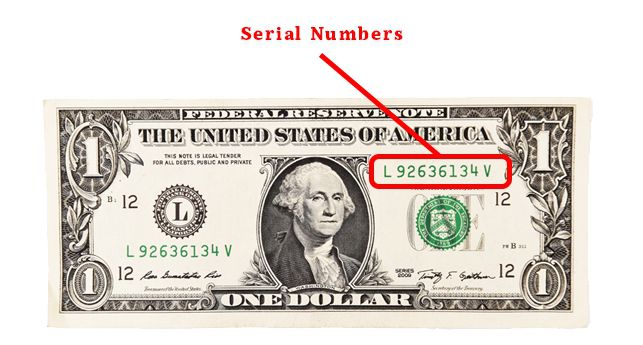
It may sound like innocent – although expensive – fun. But there was a more sinister aspect to the way the game evolved. The trading desks at Salomon Brothers were supported by teams of junior number-crunching quants who aspired to work their way up to higher-paying positions as traders. To move up the ladder, the younger quants felt obliged to join the uninhibited, macho traders on outings to saloons and strip joints – and it was the young quants who often got stuck paying the bill. And before long, the more senior traders figured out that liar’s poker was another way to exploit the junior quants who were desperate for promotion to the coveted seats on the trading desk.
You can read about this in great detail in Aaron Brown’s book, The Poker Face Of Wall Street, but this is the key point: A player is in a disadvantageous position in liar’s poker if he’s one of the last in the circle to make a bid – with each previous player upping the bid, the odds of having a better “hand” grows smaller as each person takes his turn. So the senior traders made sure that the quants were last in the circle of players to bid.
In addition, junior traders tended to try to ingratiate themselves with the top traders by not challenging their bids. That meant fewer losing hands for the boss, and more for the victims of the setup.
In short, says Brown, liar’s poker was rigged – an organized method of extracting money from the young quants.
Brown had put his Harvard math degree to work as a risk manager at a number of big investment banks, such as JPMorgan and Morgan Stanley, in the 1980s – where he saw first-hand the unevenness of liar’s poker.
Brown rebelled against this naked exploitation by young quants by seasoned traders. To right the injustice, he set about to bust liar’s poker. He watched and analyzed many rounds of the game. It revealed that the traders didn’t truly understand the odds, which led them to make bids that were too low and too predictable.
Under Brown’s tutelage, the young quants gained a superior understanding of the probabilities. They made bids that seemed too high to the traders – but which in reality had a strong likelihood of surviving a challenge and winning the round. Brown wrote a computer simulator that enabled the quants to practice thousands of hands, giving them more experience than even the most avid liar’s poker players had. He also encouraged them to make their bids in rapid-fire fashion, which unnerved the traders by showing that they had perfected a system.
When the young quants began winning by employing Brown’s system, the traders accused the quants and Brown of cheating, but it was nothing of the kind. It was a triumph of smart play over sinister tactics.
Before long, liar’s poker disappeared from Salomon Brothers and other Wall Street trading floors. Brown modestly does not take credit for killing it, noting that games come and go in the ordinary course of events. But there’s no question that he helped a lot of hard-working and deserving quants, many of whom went on to highly successful trading careers.
The takeaway for investors is best summed up by Warren Buffett: “If you’ve been playing poker for half an hour and you still don’t know who the patsy is, you’re the patsy.” Meaning, don’t get into a game – or an investment strategy – where you have no real chance of winning.
An investor who consistently beats the market needs others to be consistently on the wrong side of the trade. Don’t persist with a strategy that makes you the one who’s making money for someone else. Instead, adopt a demonstrably successful approach – such as Porter’s formula of owning capital efficient companies with reliably renewable revenue. Or distressed investing, which requires doing the research to find the individual beaten-down bonds that will become the winners, which many other investors have written off as duds.
If you’re not already a subscriber to Distressed Investing… see what we’re talking about here, or call Lance James, our Director of Customer Care, at 888-610-8895 or internationally at +1 443-815-4447, for more information on becoming a subscriber.
Three Things To Know Before We Go…
1. Fund managers show no fear. Bank of America surveyed 205 money managers, overseeing $482 billion in assets, revealing that cash levels have dropped to 3.5% of assets under management – which is the lowest level of cash in 15 years. The respondents also expressed little fear of a slowdown, with 82% believing a global recession is unlikely over the next year – the highest level of optimism since 2022. With so much money invested in the market, there’s little room for error in these bullish forecasts.

2. Growing consumer-credit delinquencies. Last week, we highlighted that consumer debt levels soared to record levels – over $5 trillion – as Americans turn to plastic to keep up with inflation. Now because of rising interest rates, consumers are struggling to repay these loans. The average credit card interest rate is 21.5%, compared to an average of 12.9% between 2010 and 2020. Serious delinquencies climbed to 11.4% in Q4 2024 – the highest level since 2011. Consumer defaults are on the rise, with the lower-income segment feeling the brunt of the financial strain. And when consumers can no longer lean on credit for cash to spend, they’ll have no choice but to slow their spending.

3. The U.S. housing market is slowly melting. The average U.S. house in January sold for 1.8% less than its asking price – the biggest discount in two years. And it’s taking longer for homes to sell: on average, a house is on the market for 56 days before the sale sign is removed from the front yard… the longest sales period since 2019. And so it’s not surprising that more than half of listings still aren’t under contract after having been on the market for 60 days. Weakness in the housing market reflects – like higher credit card delinquency rates – continued pressure on the consumer, and a faltering economy… and good news (for house buyers), as it may signal the beginning of residential real estate creeping back toward affordability.
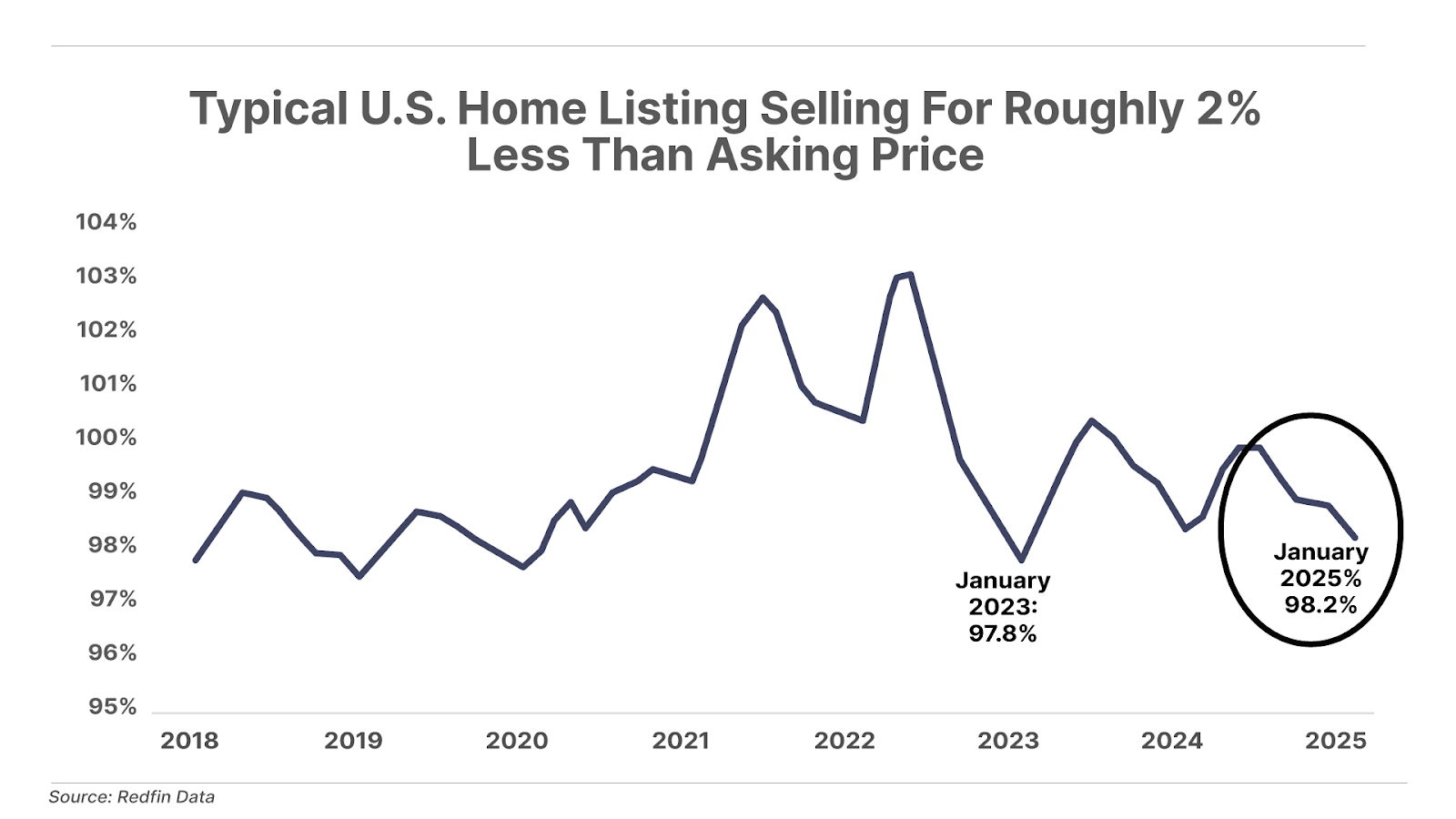
And one more thing… A Healthy 18% Jump
Michael Burry – the hedge fund manager of The Big Short fame who made billions on the subprime-mortgage crisis of 2008-2010 – went big into one of our Trump’s Secret Stocks portfolio positions… a company co-founded by someone close to Trump that’s focused on using technology to make healthcare more affordable. And yesterday’s disclosure of Burry’s purchase late last year pushed the shares of this stock up 18% for the day. (Partner Pass members read about this yesterday on our Direct Line service.) If you’re a Big Secret subscriber (or Partner Pass member), you can read our Trump’s Secret Stocks report here… if you’re not and want to learn more, go here.
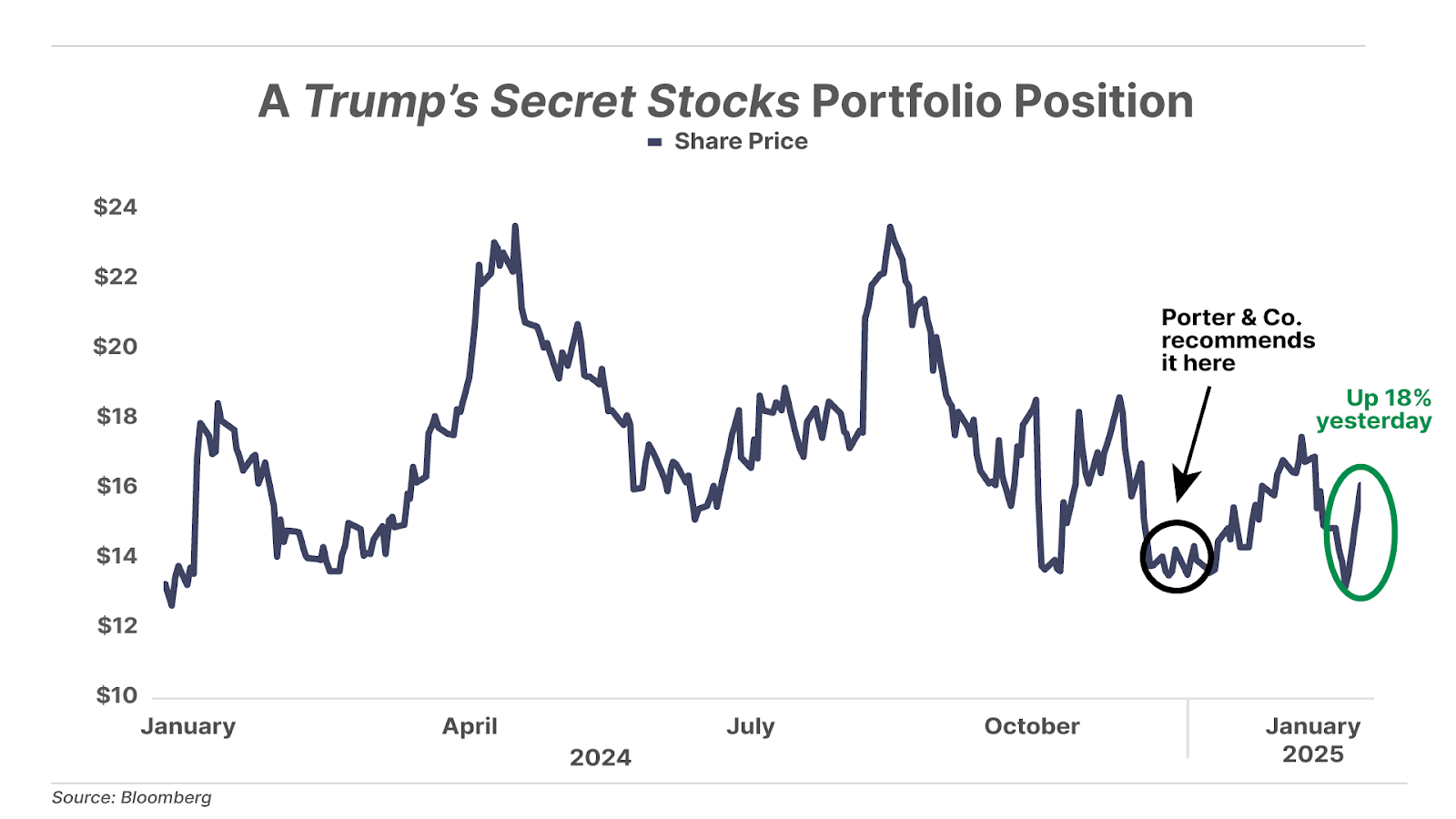
Poll Results… Fed Rate Hike
On Friday, our poll asked: “When do you think the next Fed rate hike will happen?” Ever since the Federal Reserve began to cut rates in September 2024, market chatter has centered on anticipation over the next rate cut… rather than the next rate hike.
But as inflation remains stubbornly high (as we’ve warned), that dynamic is shifting. Last week, two higher-than-expected inflation numbers for January were released – the consumer price index (“CPI”) rose 0.5% (versus expectations of 0.3%), for an annual inflation rate of 3.0%… and the producer price index (“PPI”) – a measure of inflation at the wholesale level – rose 0.4% in January (versus expectations of 0.2%), for a 3.5% annual rate. Rising inflation, of course, spells bad news for Federal Reserve rate cuts – which is why our poll question asked about a rate hike, rather than a cut.
And the dynamic has in fact flipped: 41% of survey takers think the Fed will raise rates this year, while 45% think it will next happen in 2026. Only 15% see the Fed waiting two years or more.
By comparison… betting market Kalshi – which allows people to put real money behind their predictions about various issues – shows 26% of bettors anticipating a rate hike before 2026.
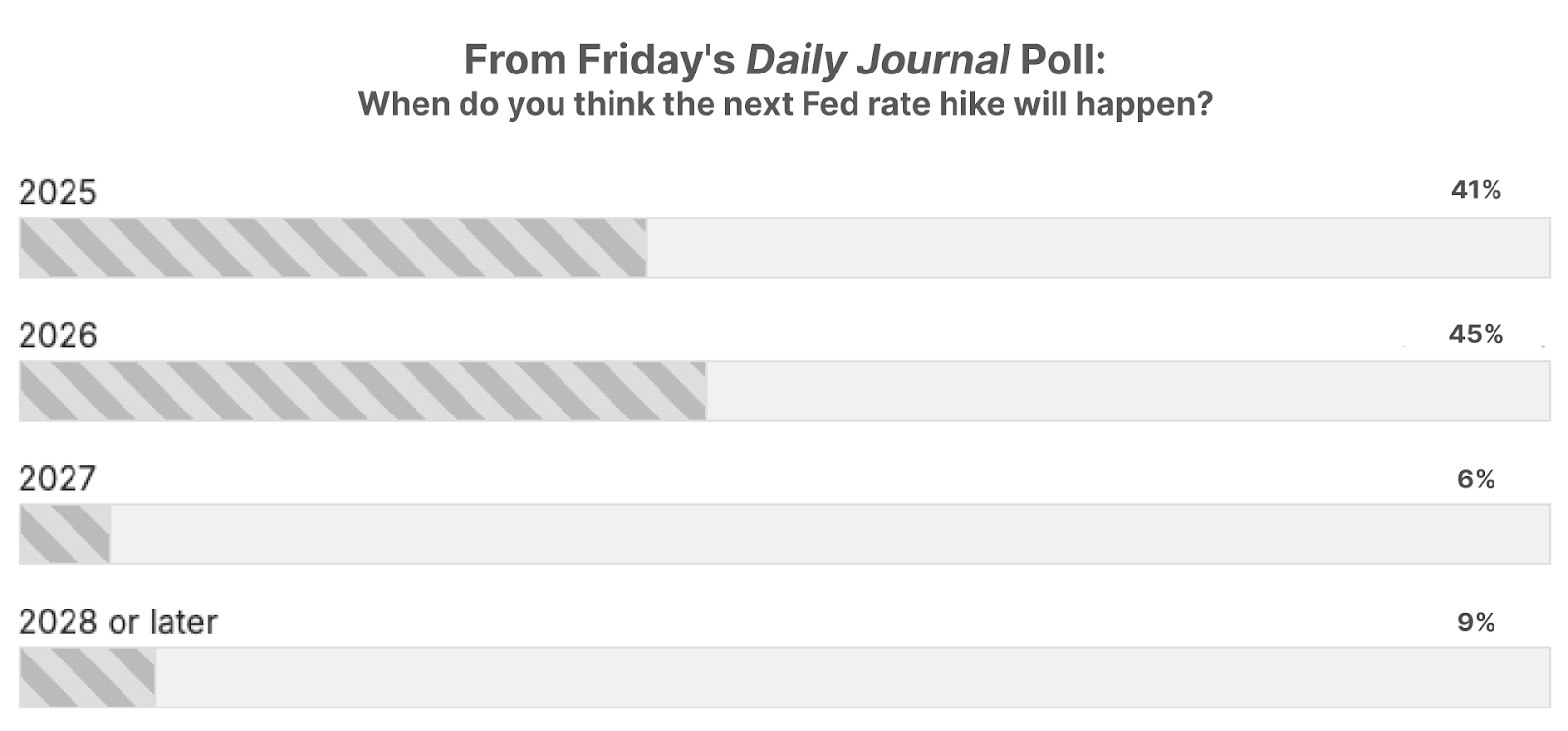
Let us know what you think… good or bad, [email protected]
Porter & Co.
Stevenson, MD
P.S. If you’re looking for conventional wisdom or the party line… don’t bother with Mason Sexton.
Here at Porter & Co. we’ve heard from people who love Mason… and people who very clearly don’t love him.
What’s undeniable, though, is that – no matter how much you doubt his highly unorthodox methods – Mason manages to nail it… every time.
In other words: Mason is uncannily right, with uncanny frequency. And if you’re looking for insight on what’s happening next in markets, that’s mighty helpful.
For example… in October 1987, 11 days before it happened, Mason predicted that the stock market was about to crash.
In March 2008, called the bottom of the Global Financial Crisis crash.
And in early 2020, he warned that the top was in, and that it was time to sell… right before the Nasdaq collapsed by 36% in the COVID crash.
And now… Mason believes that something big – very big – is brewing in markets. And that it’s going to happen within the next two months.
So big… that Mason is calling it The Prophecy. He reveals in a special interview what he sees happening… when it all will start… and what you can do to prepare.

